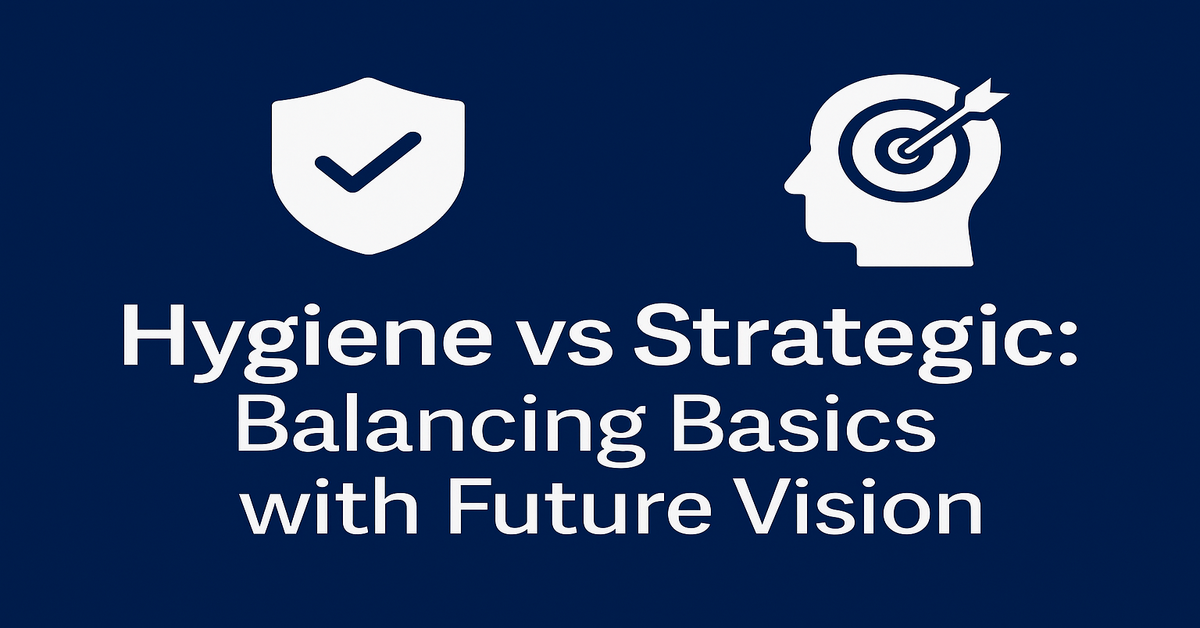
In the world of business, management, and organizational development, the terms Hygiene vs Strategic are often used to categorize priorities, actions, and decisions. While both terms are essential, they represent two very different layers of thinking and problem-solving. Hygiene refers to the basic, foundational, and necessary elements that must be maintained to avoid dissatisfaction, inefficiency, or breakdowns in performance. Strategic, on the other hand, refers to long-term planning, competitive positioning, and forward-looking decisions that shape the future growth and identity of an organization.
Understanding the difference between hygiene and strategic factors is crucial for leaders, managers, employees, and even individuals managing their careers or personal goals. This article explores hygiene vs strategic in depth, looking at definitions, importance, differences, applications, and real-world examples. We will also analyze how organizations can balance hygiene factors with strategic priorities to ensure both operational stability and future growth.
1. Defining Hygiene in Business Context
The term “hygiene” in a business or organizational context is derived from the idea of basic cleanliness and necessary maintenance. Just like personal hygiene prevents illness, organizational hygiene prevents inefficiency, dissatisfaction, and breakdown. Hygiene factors are not glamorous, but absolutely necessary.
Key characteristics of hygiene in business include:
- Preventive nature: Hygiene activities prevent dissatisfaction but do not necessarily create motivation or competitive advantage.
- Short-term stability: They address immediate problems and keep operations smooth.
- Foundational: Without hygiene factors, no strategy will succeed, because the foundation is weak.
- Maintenance-based: Hygiene is about maintaining systems, processes, and employee satisfaction at a minimal level.
Examples of hygiene factors in business include:
- Fair salaries and compensation.
- Safe working conditions.
- Compliance with legal and regulatory standards.
- Providing employees with basic tools and resources to perform their jobs.
- Proper communication channels.
- Regular equipment maintenance.
2. Defining Strategic in Business Context
Strategic refers to long-term, future-oriented actions and decisions that position an organization for growth, competitiveness, and sustainability. Strategies go beyond immediate fixes and aim to differentiate a company, capture market share, and create unique value propositions.
Key characteristics of strategic factors include:
- Forward-looking: Designed with the future in mind.
- Differentiation-focused: Aim to provide competitive advantage and uniqueness.
- Growth-oriented: Concerned with long-term survival, scalability, and innovation.
- Visionary: Aligned with company mission, vision, and values.
Examples of strategic factors in business include:
- Investing in research and development to create new products.
- Expanding into international markets.
- Building a brand identity and reputation.
- Adopting advanced technologies to gain competitive advantage.
- Training employees for future leadership roles.
- Formulating five-year growth plans.
3. Hygiene vs Strategic: The Core Differences
The differences between hygiene and strategic can be understood across several dimensions.
| Dimension | Hygiene | Strategic |
|---|---|---|
| Purpose | Prevent dissatisfaction and maintain smooth operations | Create differentiation and long-term growth |
| Time Horizon | Short-term, immediate fixes | Long-term, future planning |
| Value Contribution | Maintains baseline efficiency | Adds competitive advantage |
| Impact | Necessary but not sufficient for growth | Essential for sustainability and expansion |
| Examples | Salaries, compliance, working conditions | Market expansion, innovation, branding |
4. The Link Between Hygiene and Strategic
It is important to note that hygiene and strategic factors are not opposites, but rather complementary layers of organizational management.
- Without hygiene, strategies fail. For example, a company cannot expand into new markets (strategic) if it has unresolved labor disputes or non-compliance issues (hygiene).
- Without strategy, hygiene keeps an organization stagnant. A company may have happy employees and stable operations, but without a long-term vision, it cannot grow or stay competitive.
Thus, successful organizations balance both hygiene and strategic priorities.
5. Hygiene vs Strategic in Human Resource Management
Human resource management (HRM) is one of the clearest fields where hygiene vs strategic differences can be observed.
- Hygiene HR Factors:
- Fair pay and benefits.
- Safe workplace.
- Employee rights compliance.
- Basic job security.
- Strategic HR Factors:
- Leadership development programs.
- Succession planning.
- Creating a strong employer brand.
- Employee engagement strategies.
Example: If a company only focuses on paying employees fairly (hygiene), employees may stay but won’t be deeply motivated. When combined with career development and recognition (strategic), employees become more engaged and loyal.
6. Hygiene vs Strategic in Marketing
Marketing also shows a strong contrast between hygiene and strategic elements.
- Hygiene Marketing Factors:
- Having an updated website.
- Basic social media presence.
- Providing accurate product information.
- Meeting legal advertising standards.
- Strategic Marketing Factors:
- Building a unique brand story.
- Creating emotional connections with consumers.
- Market segmentation and targeted campaigns.
- Investing in customer experience innovation.
Example: Having a functional website is hygiene. Developing a personalized digital experience for customers is strategic.
7. Hygiene vs Strategic in Operations
Operations also reflect this distinction:
- Hygiene Operations:
- Maintaining equipment.
- Meeting safety standards.
- Efficient supply chain basics.
- On-time payroll.
- Strategic Operations:
- Adopting AI and automation for future scalability.
- Building resilient global supply chains.
- Designing sustainable manufacturing systems.
Example: Ensuring a machine is operational is hygiene. Using predictive analytics to optimize production is Hygiene vs Strategic.
8. Hygiene vs Strategic in Personal Growth
Even individuals can apply this distinction to their lives.
- Hygiene in Personal Growth:
- Good sleep, nutrition, exercise.
- Basic job skills.
- Time management.
- Stress management.
- Strategic in Personal Growth:
- Long-term career planning.
- Building a professional network.
- Pursuing advanced degrees or certifications.
- Developing leadership skills.
Example: Being punctual at work is hygiene. Building a reputation as a thought leader in your field is strategic.
9. Why Both Are Necessary
Focusing only on hygiene leads to stability but no growth. Focusing only on strategic leads to vision without foundation. Organizations need both:
- Hygiene provides the foundation of trust and stability.
- Strategy provides the path to differentiation and growth.
10. Case Study Example
Imagine two companies:
- Company A focuses only on hygiene: paying salaries, maintaining a safe environment, and following regulations. It survives but does not grow.
- Company B focuses on hygiene and then invests in innovation, branding, and market expansion. It grows, builds reputation, and becomes competitive.
The difference lies in balancing both hygiene and strategic priorities.
11. Practical Steps to Balance Hygiene and Strategic
- Audit hygiene factors regularly to ensure compliance and employee satisfaction.
- Identify strategic priorities aligned with long-term vision.
- Allocate resources fairly between maintenance and innovation.
- Communicate balance so employees understand both immediate needs and long-term vision.
- Monitor progress in both areas through KPIs.
12. Summary Table
| Aspect | Hygiene | Strategic |
|---|---|---|
| HR | Fair pay, compliance | Leadership, branding |
| Marketing | Website, info accuracy | Storytelling, experience |
| Operations | Equipment maintenance | AI, sustainability |
| Personal Growth | Sleep, time mgmt | Networking, leadership |
13. Long-Term Implications
Companies that neglect Hygiene vs Strategic face employee dissatisfaction, compliance risks, and inefficiency. Companies that neglect strategy face stagnation, loss of competitiveness, and irrelevance. The healthiest organizations integrate both.
Conclusion
The distinction between hygiene vs strategic is fundamental in business and personal growth. Hygiene provides the necessary foundation, preventing dissatisfaction and ensuring smooth operations. Strategic initiatives, on the other hand, propel individuals and organizations into the future, offering competitive advantage, growth, and sustainability. Only by recognizing and balancing both dimensions can true success be achieved.
FAQs
1. What is the difference between hygiene and strategic in business?
Hygiene vs Strategic refers to the basic, foundational elements like compliance, pay, and safety that prevent dissatisfaction. Strategic refers to long-term, growth-oriented actions like branding, innovation, and expansion that differentiate and sustain businesses.
2. Can an organization survive with only hygiene factors?
Yes, it can survive but not thrive. Hygiene vs Strategic ensures stability, but without strategy, the organization risks stagnation and loss of competitiveness.
3. Why are hygiene factors not enough for motivation?
Hygiene factors prevent dissatisfaction but do not inspire passion or loyalty. Motivation and engagement require strategic factors like career development and vision.
4. How do hygiene and strategic apply to individuals?
For individuals, hygiene includes health, basic skills, and punctuality. Strategic factors include networking, advanced education, and long-term career planning.
5. How can companies balance hygiene and strategic effectively?
By auditing hygiene regularly, aligning strategy with vision, allocating resources to both areas, and monitoring progress using clear performance indicators.







